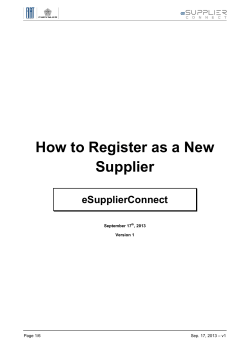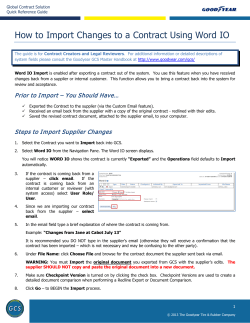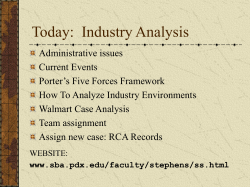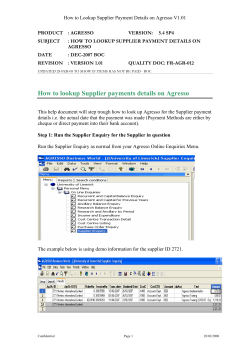
W How to recover well in business-to-business strategic reflections
strategic reflections How to recover well in business-to-business By Lance A. Bettencourt Partner and co-founder Service 360 Partners with Mark B. Houston Eunice and James L. West chair of American enterprise and professor of marketing at Neeley School of Business Texas Christian University hen a product or service failure occurs it should be every company’s goal to recover well. Research demonstrates that customer satisfaction with a company’s recovery efforts impacts overall satisfaction, loyalty and wordof-mouth. We highly recommend “The profitable art of service recovery” (Harvard Business Review, 1990) and “Recovering and learning from service failure” (MIT Sloan Management Review, 1998) for practical managerial guidance. Unfortunately nearly all studies and managerial recommendations on service recovery and complaint handling come from the world of consumer products and services. Yet problems are no less prevalent in business-to-business contexts, nor is the importance of effective recovery any less significant. In fact with millions of dollars often on the line in very complex operations, one could readily argue that a plan for effective recovery is more important in B2B. Interviews we have conducted with commercial buyers, for example, frequently include stories of exceptional or poor recovery as the reason a business relationship either solidifies or deteriorates. W On the favorable side, a buyer offered, “I feel stronger about the relationship because they made the commitment to work through it.” Following a story of poor recovery, a buyer said, “We lost trust with this supplier because of their inability to execute, to be forthcoming about problems.” This column’s purpose is to describe a simple three-step model of recovery management for B2B suppliers by drawing on the interviews we have conducted. (See the figure on Page 13.) Anticipate and Christopher P. Blocker Assistant professor of marketing at Hankamer School of Business Baylor University One of the basics of good recovery management is identifying issues and being prepared to resolve them when they arise. In B2B, there are no comment cards and a 1-800-SUPPORT line is unappealing to executives who want to rely on personal connections to fix problems, which are more likely to be communicated and resolved to the customer’s satisfaction when connections exist between organizations at the grassroots level and these connections have regular communication. Also, for each customer contact, whom to approach for a particular issue should be transparent, and supplier contacts must have latitude to make decisions to handle problems. “I would say that for 70 to 75 percent of the problems that we experience,” a buyer summarizes, “I don’t even hear about it until it’s already taken care of. The guy in our plant will be calling his counterpart and saying, ‘Gee, how about such and such?’ They fix the problem, and that is the essence of a good relationship.” A unique aspect of many supplier failures is they can be identified in advance and shared with specific customers. Clients expect a supplier to anticipate eventual effects of supply or production disruptions and be forthcoming with information about them. “Don’t let us find the shipment didn’t get delivered today,” a buyer says. “Tell us in R VELOCITY® EPRINT ••12•• VOL. 15 ISSUE 2 2013 COPYRIGHT© 2013 STRATEGIC ACCOUNT MANAGEMENT ASSOCIATION. ALL RIGHTS RESERVED. REPRODUCTION OR DISTRIBUTION WITHOUT EXPRESSED PERMISSION IS STRICTLY PROHIBITED. advance. Tell us that the trucker got delayed and that it will be several hours late and going directly to the plant. There are no surprises.” customer’s part. This requires the supplier to build recovery capabilities into its culture, structure, practices and systems before problems occur. When in doubt, it is best to share information with customers and allow them to have input into the next steps. Illustrating the importance of such capabilities, a buyer shares, “A lot of corporations, their divisions are so divided up that it’s difficult to get a one-person relationship. That’s frustrating. I don’t care if you have 200 divisions that you have to work with. Last thing I want to hear is excuses of why your engineering department didn’t meet your request and things like that.” Elaborating on a situation that led to lost trust, a buyer explains, “We ran out of supply, and it was a surprise to us as opposed to them communicating to us upfront. It wasn’t a relationship where they picked up the phone and said, ‘Hey, we’ve got a problem. We just found it, and here’s how we’re trying to fix it. I needed you to know, and I wanted you to hear it from me.’ It was, ‘Well, let’s just move it and see if they find it.’” Unlike many consumer failures, supply issues may substantially impact customer operations and be rightly considered crises. As such, collaboration is needed between supplier and customer contacts to partners. That means that when I’ve got a problem, you’ve got a problem, and we need to just put everything aside and work it out.” Improve In both consumer and B2B contexts the ability to resolve one problem should not be considered the end of good recovery. The organization must learn from specific recovery situations and fix any underlying system deficiencies. “Anytime you have human involvement,” a buyer shares, “there are going to be mistakes. That is understandable. A couple of mistakes are one thing. A pattern of continual screw-ups, that is not acceptable.” A supplier needs to create and Anticipate Resolve Improve Connections Capabilities System Information Resources Recovery plans quickly resolve issues. Suppliers must be prepared to allocate physical and human resources to match an issue’s severity and urgency. Most problems affecting customer operations demand the on-site presence of individuals the customer trusts—people with the expertise to fix the issue and ability to make decisions that matter. regularly update recovery plans for certain recurring issues. For example, if a company has just had a raw material shortage due to political unrest somewhere, the company should assess what did and didn’t work well in its response and document factors to routinely track to ensure that it is able to more accurately forecast disruptions. In fact the best plans anticipate potential problems so preparations can be made to avoid interruptions to supply quality or volume. Resolve Regardless of whether an issue is communicated by or to a supplier, it must take responsibility and openly share the situation’s cause and the steps it will take for resolution. Customers say accepting responsibility and having a plan to resolve a problem are critical for showing relationship commitment. When resolving a product or service failure, the customer expects the problem to be resolved completely and quickly with little effort on the “I really do think of suppliers as being an extension of us,” a buyer says, “and I expect them to be R VELOCITY® EPRINT ••13•• VOL. 15 ISSUE 2 2013 COPYRIGHT© 2013 STRATEGIC ACCOUNT MANAGEMENT ASSOCIATION. ALL RIGHTS RESERVED. REPRODUCTION OR DISTRIBUTION WITHOUT EXPRESSED PERMISSION IS STRICTLY PROHIBITED. strategic reflections ‘When I’ve got a problem, you’ve got a problem, and we need to just put everything aside and work it out.’ Contingency plans also should incorporate customer feedback. In addition to forecasting possible supply difficulties, these plans must be developed for key phases in customer operations when an issue might be experienced, such as during production start-up, product transitions and so on. What help do customers need? What information do they want to know? When do (continued) they want to know it? How do they want it communicated? Conclusion Exceptional recovery is not the sole domain of companies serving consumers. Recovery can and should be a priority for B2B companies, as well. “I have always felt that the defining moment with a supplier is how they take care of you in a problem,” a buyer says. “You don’t want problems, but they happen all the time. And how a supplier reacts or doesn’t react has a lot to do with who we choose to do business with. People who say, ‘Service is our middle name,’ if they don’t come through in those times, you tend to question their commitment to you or if they are really worth it.” To be a supplier companies choose to do business with, a supplier must make it a priority to understand what customers expect when things go wrong, then design systems, processes and structures for effective recovery management. Lance A. Bettencourt is partner and co-founder of the consultancy Service 360 Partners (www. service360partners.com) and can be reached at lance@service360partners.com or 812824-2286. He can also be found at www. linkedin.com/in/lancebettencourt and www. twitter.com/service360. Mark B. Houston is Eunice and James L. West chair of American enterprise and professor of marketing at Neeley School of Business at Texas Christian University (www.tcu.edu) and can be reached at m.b.houston@tcu.edu or 817-257-7153. Christopher P. Blocker is assistant professor of marketing at Hankamer School of Business at Baylor University (www.baylor.edu) and can be reached at chris_blocker@baylor.edu or 254-710-4595. He can also be found at www. linkedin.com/in/cblocker. This survey from 2012 covers the current state of the art and science of strategic account management. It will help any strategic account manager, program director or executive make more informed and reasoned decisions on strategy, infrastructure, processes and resource deployment. SAMA partnered with the consulting firm Walker Information Inc. to complete this research. Corporate member: $225 Individual member: $250 Non-member: $500 *Free with participation
© Copyright 2025





















